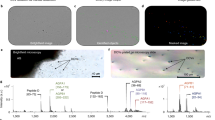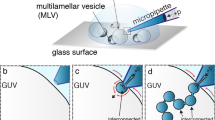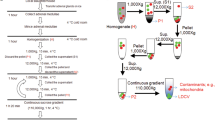Abstract
A number of intracellular, membrane-bound compartments in both the endocytic and exocytic pathways of eukaryotic cells have an acidic internal pH1. In endocrine cells, the mature secretory vesicle has an acidic pH; secretory vesicles isolated from exocrine cells, however, appear to have a neutral pH2. Recently we have used a newly developed immunocytochemical technique3 to map low-pH compartments in insulin-secreting islet cells with the electron microscope and find that during the maturation of the secretory vesicle there is a progressive acidification of these vesicles that begins as soon as the trans Golgi condensing vacuoles form4. Now we have used this technique to examine two exocrine cells: the pancreatic acinar cell and the parotid serous cell. In both cell types, the trans Golgi condensing vacuoles are acidic and accumulate the low-pH probe to the same extent as condensing vacuoles of insulin-secreting islet cells. Unlike insulin-secreting cells, however, maturation of the granules is accompanied by a return of luminal pH to near neutrality. Therefore, although the pH of storage granules in exocrine and endocrine cells is different, the pH of the condensing vacuoles in both cells is acidic.
This is a preview of subscription content, access via your institution
Access options
Subscribe to this journal
Receive 51 print issues and online access
$199.00 per year
only $3.90 per issue
Buy this article
- Purchase on Springer Link
- Instant access to full article PDF
Prices may be subject to local taxes which are calculated during checkout
Similar content being viewed by others
References
Mellman, I., Fuchs, R. & Helenius, A. A. Rev. Biochem. 55, 663–700 (1986).
Arvan, P., Rudnick, G. & Castle, J. D. J. biol. Chem. 260, 14945–14952 (1985).
Anderson, R. G. W., Falck, J. R., Goldstein, J. L. & Brown, M. S. Proc. natn. Acad. Sci. U.S.A. 81, 4838–4842 (1984).
Orci, L. et al. J. Cell Biol. 103, 2273–2281 (1986).
Anderson, R. G. W. & Pathak, R. K. Cell 40, 635–643 (1985).
Griffiths, G. & Simons, K. Science 234, 438–443 (1986).
Steiner, D. F., Docherty, K. & Carroll, R. J. cell. Biochem. 24, 121–130 (1984).
Kelly, R. B. Science 230, 25–32 (1985).
Griffiths, G., Quinn, P. & Warren, G. J. Cell Biol. 96, 835–850 (1983).
Moore, H-P., Gumbiner, B. & Kelly, R. B. Nature 302, 434 (1983).
Kawai, K., Ipp, E., Orci, L., Perrelet, A. & Unger, R. H. Science 218, 477–478 (1982).
Lombardi, T. et al. Nature 313, 694–696 (1985).
Caplan, M. J. et al. J. Cell. Biol. 103, 8a (1986).
Bruzzone, R., Halban, P. A., Gjinovci, A. & Trimble, E. R. Biochem. J. 226, 621–624 (1985).
Roth, J., Bendayan, M. & Orci, L. J. Histochem. Cytochem. 26, 1074–1081 (1978).
Coons, A. H., Leduc, E. H. & Connolly, J. M. J. exp. Med. 102, 49–63 (1955).
Maxwell, M. H. J. Microsc. 112, 253–255 (1978).
Author information
Authors and Affiliations
Rights and permissions
About this article
Cite this article
Orci, L., Ravazzola, M. & Anderson, R. The condensing vacuole of exocrine cells is more acidic than the mature secretory vesicle. Nature 326, 77–79 (1987). https://doi.org/10.1038/326077a0
Received:
Accepted:
Published:
Issue Date:
DOI: https://doi.org/10.1038/326077a0
This article is cited by
-
The pH of the perisymbiont space in the green hydra-Chlorella symbiosis
Protoplasma (1992)
-
Membrane fluidity of platelets and erythrocytes in patients with Alzheimer's disease and the effect of small amounts of aluminium on platelet and erythrocyte membranes
Neurochemical Research (1992)
-
Autophagy and other vacuolar protein degradation mechanisms
Experientia (1992)
-
The relationship between synthesis of secretory products and reducing capacity in pancreas and parotid acinar cells
The Histochemical Journal (1991)
-
Localization of lysosomal and digestive enzymes in cytoplasmic vacuoles in caerulein-pancreatitis
Histochemistry (1990)
Comments
By submitting a comment you agree to abide by our Terms and Community Guidelines. If you find something abusive or that does not comply with our terms or guidelines please flag it as inappropriate.



